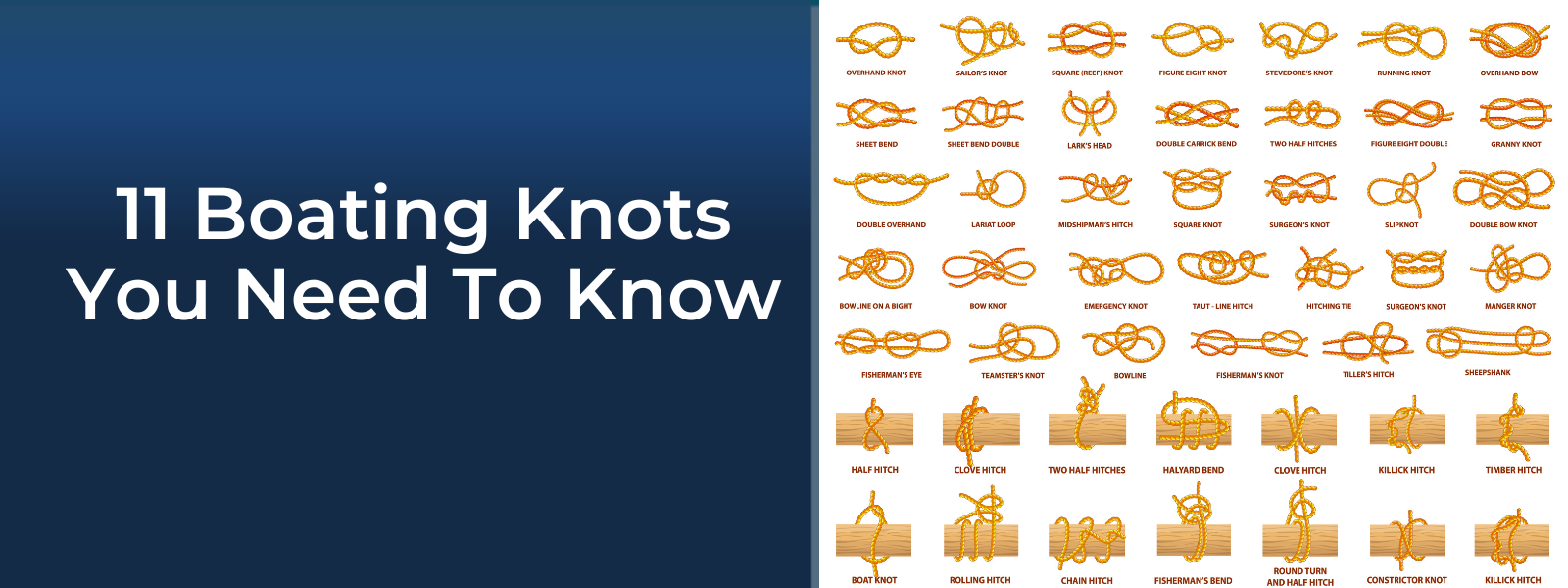Nautical Knots for Boating And Sailing: Here Is A List Of The Top Boating Knots You Should Know:

Table of Contents
Nautical Knots for Boating And Sailing: Here Is A List Of The Top Boating Knots You Should Know:
Boating and sailing not only require skill and knowledge of navigation but also a mastery of various knots. These knots ensure safety, efficiency, and reliability. Whether you’re mooring, anchoring, or securing sails, the right knot can make all the difference. Here’s an expanded and detailed guide on essential boating knots, including their uses and step-by-step instructions.
Essential Boating Knots
Half Hitch
Uses: The Half Hitch is often used in combination with other knots to add security. On its own, it’s a quick and simple way to temporarily secure a rope to a post, ring, or another rope. It’s not highly secure by itself but is a fundamental component of many more complex knots and hitches used in boating and sailing.
How to tie:
- Pass the end of the rope around the object (post, ring, etc.) to which you’re attaching it.
- Bring the end of the rope over and around the standing part.
- Pass the end through the loop you’ve just created.
- Pull tight to secure the hitch.
Note: For added security, multiple half hitches can be used in succession, and they are often combined with other knots to secure the rope more firmly.
Video link: How to Tie a Half Hitch
Uses: The bowline creates a secure loop at the end of a line, ideal for attaching to mooring posts, rings, or through items you’re securing. It’s vital for boating and sailing because it doesn’t slip or bind.
How to tie:
- Create a small loop in the standing part of the line, known as the ‘rabbit hole.’
- Tighten by pulling the standing part while holding the loop and tail.
- Pass the end of the line (the rabbit) up through the loop, around the standing part (the tree), and back down through the loop.
Video link: How to Tie a Bowline Knot
Uses: Essential for securing your boat to a dock or cleat. This knot is quick to tie and release, even under load.
How to tie:
-
Wrap the line around the base of the cleat, once completely.
- Make a figure-eight pattern around the arms of the cleat.
- On the final wrap, form an underhand loop and slip it over the arm of the cleat.
- Pull tight to secure.
Video link: How to Tie a Cleat Hitch
Uses: A stopper knot, preventing the end of a rope from fraying or slipping through a pulley or block.
How to tie:
-
Make a loop by twisting the rope on itself.
- Pass the end of the rope over the standing part, then back through the loop you created.
- Pull tight to form the figure-eight shape.
Video link: How to Tie a Figure-Eight Knot
Uses: Joining two ropes of equal thickness, ideal for securing reefing lines or tying off sail material. Not recommended for critical applications due to slippage with uneven loads.
How to tie:
- Take two rope ends, one in each hand.
- Tie a simple overhand knot by passing the right end over the left, then under it.
- Tie another overhand knot, this time passing the left end over the right, then under it.
- Pull both ends to tighten the knot.
Video link: How to Tie a Square Knot
Uses: Joining two ropes of different thicknesses. It’s especially useful in sailing for attaching sheets (lines that control the sails) to the sails themselves.
How to tie:
-
Make a bight (a U-shape) with the thicker or more slippery rope.
- Pass the end of the other rope through the bight from behind.
- Wrap the end around both parts of the bight, then back under itself.
- Pull tight to secure.
Video link: How to Tie a Sheet Bend
Uses: Securing a rope to a pole or ring, useful in mooring and securing tarps or covers.
How to tie:
-
Pass the rope around the object.
- Bring the end over and around the standing part, then through the loop created (first half hitch).
- Repeat the process to create the second half hitch.
- Tighten both half hitches against the object.
Video link: How to Tie a Double Half Hitch
Uses: Attaching a rope to a pole, another rope, or to relieve tension on a jammed rope or pulley in sailing.
How to tie:
-
Wrap the rope around the object it’s to be attached to.
- Make a second wrap in the same direction, ensuring it lies next to the first.
- Make a third wrap, but this time cross over the first two wraps.
- Tuck the working end under the third wrap and pull tight
Video link: How to Tie a Rolling Hitch
Uses: Starting and securing lashings, tying a rope to posts, and temporary mooring. Not the most secure hitch, but quick to tie and untie.
How to tie:
-
Pass the rope around the post or object.
- Cross over the standing part to create a second wrap.
- Pass the end of the rope under the last wrap.
- Pull both ends to tighten.
Video link: How to Tie a Clove Hitch
Uses: Ideal for mooring and securing a boat to a dock or a buoy. Provides a secure attachment with the ability to adjust tension.
How to tie:
-
Wrap the rope around the object twice (round turn) for extra security.
- Tie a half hitch around the standing part of the rope, close to the object.
- Tie a second half hitch for added security.
- Tighten the knot by pulling on the standing part.
Video link: How to Tie a Round Turn and Two Half Hitches
Uses: Primarily for attaching a rope to an anchor. Known for its strength and security.
How to tie:
-
Wrap the rope around the anchor’s ring twice.
- Pass the end of the rope through the wraps in the direction opposite to the initial entry.
- Secure the end with two half hitches on the standing line.
- Tighten the knot and ensure it’s secure.
Video link: How to Tie an Anchor Bend
Most Important Sailing Knots
In sailing, knots serve critical roles in the handling and adjustment of sails, as well as in securing the vessel. Besides the universally useful Bowline and Cleat Hitch, sailors rely on several other specific knots which we have also covered in detail above:
- Bowline: Essential for creating a secure loop at the end of a halyard to attach sails.
- Cleat Hitch: Used to secure halyards and sheets to cleats on the deck.
- Figure-Eight Stopper Knot: Often tied at the end of lines to prevent them from running through pulleys.
- Single and Double Sheet Bend: Ideal for joining two lines of different sizes, commonly used to attach a jib sheet to the cleat.
- Rolling Hitch: Allows sailors to attach a line to a rod or another line under tension, useful for adjusting the tension on a line without releasing it.
Best Boat Knots To Dock A Boat:
Docking requires knots that can be both securely fastened and easily released, as conditions at the dock can change:
-
Cleat Hitch: The standard knot for tying a boat to a dock cleat, ensuring the boat stays put while allowing for quick release when needed.
-
Bowline: Used to create a loop that can be easily placed over a piling or a dock cleat.
-
Spring Line Hitch: A method of using lines at an angle to prevent the boat from moving forward or backward along the dock.
-
Fender Hitch: A quick and secure method to hang fenders on the side of the boat to protect the hull when docking.
Other Maritime Knots And Marine Knots Expanded
Beyond the basics, several knots have specialized uses in various maritime activities:
-
Carrick Bend: Used for joining two heavy lines, such as when towing or mooring.
- Stopper Knot: Essential for preventing a line from slipping through a block or a hole, with the Figure-Eight Knot being a common choice.
- Heaving Line Knot: A knot tied at the end of a light line to add weight, making it easier to throw.
Basic Boat Knots Every Boater Should Know
For those new to boating or in need of a refresher, mastering the following knots will cover most scenarios you’ll encounter:
-
Bowline: The quintessential boating knot for creating a loop that won’t slip under load.
- Cleat Hitch: Essential for docking, allowing the boat to be securely tied but quickly released when necessary.
- Figure-Eight Knot: A basic stopper knot, preventing the end of a rope from running through retainers.
- Sheet Bend: Perfect for joining two ropes of different diameters, a common need in boating.
- Half Hitch: Used for securing a rope to a post, ring, or another rope, often used in combination with other knots for added security.
Common Boating Knot Questions And Answers
What is the most useful knot for a boat?
The Cleat Hitch is arguably the most useful knot for boating. It is versatile, easy to tie, and essential for docking, making it indispensable for boaters.
What is the strongest marine knot?
The Double Fisherman’s Knot (also known as the Grapevine Bend) is considered one of the strongest knots. It is primarily used for joining two lines of similar thickness and is known for its strength and stability.
What is a good knot to tie a boat to a dock?
The Cleat Hitch is the go-to knot for tying a boat to a dock. It is secure yet easy to untie, even after being under load. Its simplicity and effectiveness make it ideal for this purpose.
What are the 4 basic maritime knots?
- Bowline: A versatile loop knot that is secure and easy to untie.
- Cleat Hitch: Essential for docking, allowing for quick and secure fastening to a cleat.
- Figure-Eight Knot: A basic stopper knot, providing a quick method to prevent a rope from running out.
- Sheet Bend: Ideal for joining two ropes of different thicknesses, essential for many boating scenarios.
What are the 4 knots essential for sailing?
The 4 basic maritime knots listed above are 4 basic knots that are considered essential for sailing. They include:
- Bowline
- Cleat Hitch:
- Figure-Eight Knot
- Sheet Bend
What are the 8 basic knots?
The 8 basic knots include the 4 basic maritime knots and 4 additional knots. Here is the full list:
- Bowline
- Cleat Hitch:
- Figure-Eight Knot
- Sheet Bend
- Reef Knot (Square Knot)
- Double Half Hitch
- Rolling Hitch
- Clove Hitch
These knots form the foundation of maritime knot-tying, covering a wide range of boating, sailing, and general maritime activities. Mastery of these knots ensures readiness for most situations encountered on the water, enhancing safety, efficiency, and the overall maritime experience.
Conclusion
In conclusion, each knot serves a specific purpose, from securing your vessel to a dock, joining ropes of different sizes, to ensuring the safety of your sails and cargo. By familiarizing yourself with these knots, you equip yourself with the knowledge and skills to handle various situations at sea confidently. Practice tying these knots regularly to ensure you can tie them correctly and efficiently when the need arises.
Happy boating!





